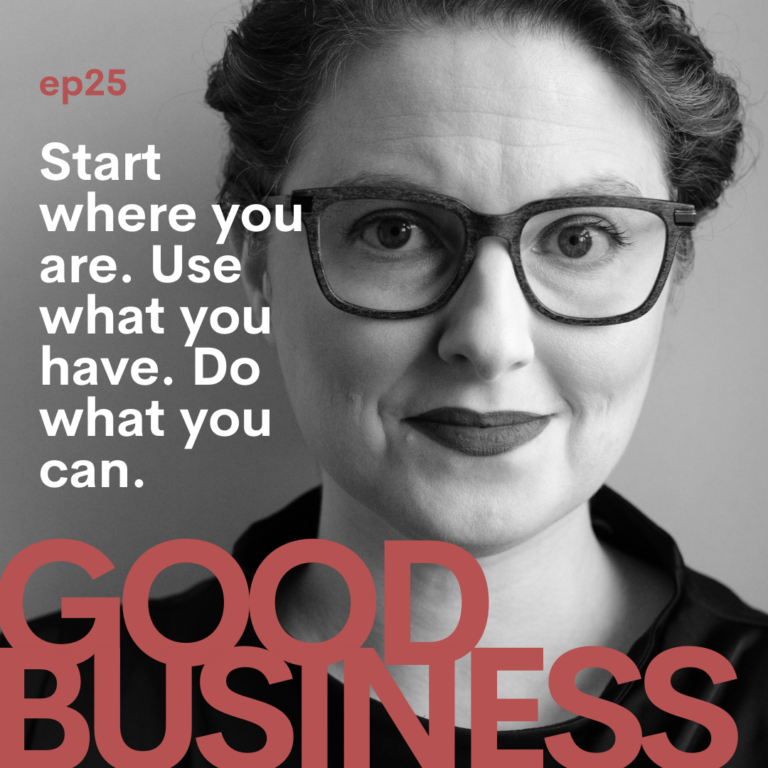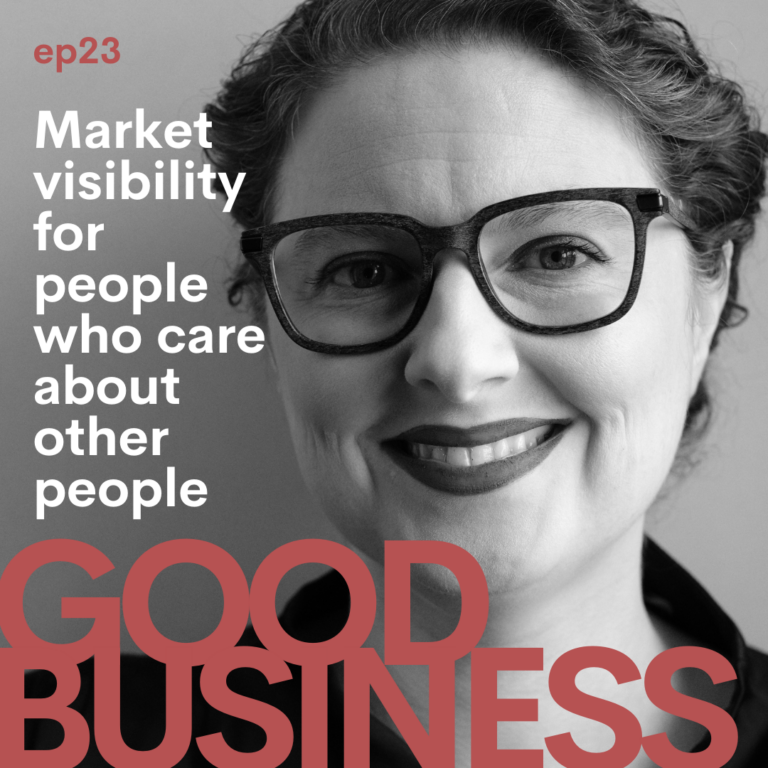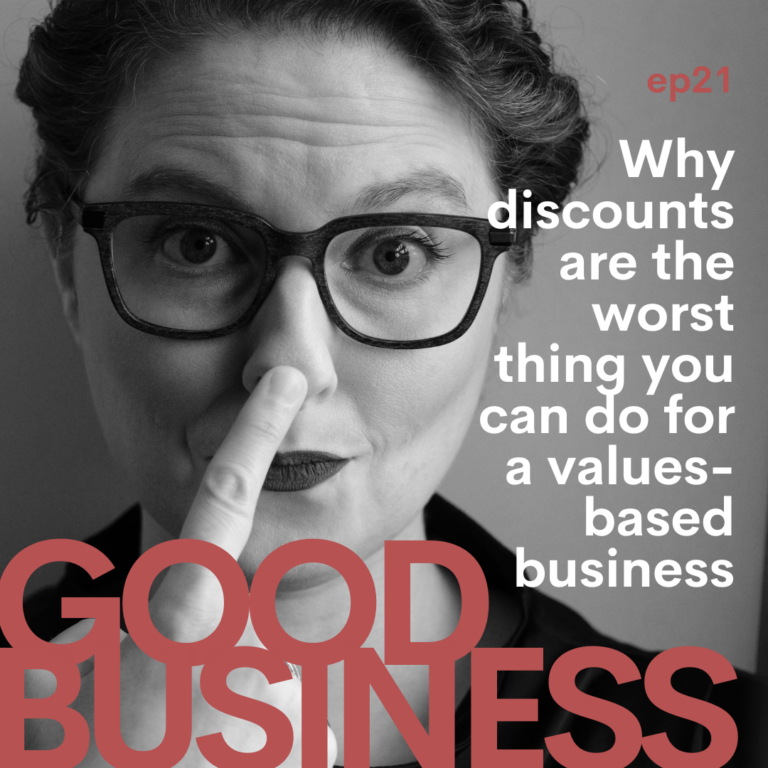Today’s episode is all about knowing the promises that you’re making and knowing if you can keep them. It’s the foundation point of any good offer, whether you are making jewelry or you are designing a new coaching program or you are creating a web design project. It doesn’t really matter. Offer design begins with a promise. What is the promise that you’re making? And do you know if you can keep it?
Episode Transcript:
Welcome back to the Good Business Podcast. I’m your host, Illana Burk. And I am delighted to have you here. Today is the beginning of a brand new series on offer design. And I am really, really excited to be sharing the next several episodes. This is a longer series than I ordinarily do. I think we’re going to be doing a total of seven episodes in this series.
The first today is about knowing your promise and being sure you can keep it. So we’ll be digging into that in a minute, but the next episode is going to be on scheduling. And how to think about the cadence of your offers and how to think about the contact that you have with your clients. Then we’re going to move on to making things as easy as they need to be, which is all about, leadership and how you think about the delivery systems that you utilize. So we’ll talk a little bit about tech in the third episode. Then we’re going to talk about delivering on your own terms so that you can create the life and the business that you’re looking for, right from the get-go instead of trying to push that out into something that you’re going to eventually get to. Then we’re going to talk about the more esoteric. What does your offer allow you to do out in the world? What does it allow you to do more of or less of? Does it create capacity or does it decrease capacity?
Then we’re going to talk about how you talk about it. So there’s going to be a marketing piece there to round it all up. And we’ll probably add in a few more things along the way in response to listener feedback to each episode. So if you have questions. Please don’t hesitate to reach out in all of the usual places. Instagram is always a great place to connect.
And without further ado, I’d like to get into it. Today’s episode is all about. Knowing the promises that you’re making. And knowing if you can keep them. It’s the foundation point of any good offer, whether you are making jewelry or you are designing a new coaching program or you are creating a web design project. It doesn’t really matter.
Offer design begins with a promise. What is the promise that you’re making? And do you know if you can keep it?
It sounds really simple. But most people don’t actually stop to do this. They think about it as a service. They think about whatever their offering is, oh, I can make a pair of earrings and all sell a pair of earrings. But what’s the promise behind that pair of earrings? What’s the promise you’re making as someone who creates or provides a service? Do you actually know? The promise is something that’s a little bit more ambiguous in a lot of businesses. If we use the jewelry example. Your promise is that you’re making someone feel beautiful or more confident or it might help them feel better about themselves in some way to know that they’re supporting a small business.
Part of your promise might be that you created something that’s going to last a really long time or that’s one of a kind. All of these things feed into your promise. It has to do with branding and your brand message, your promise that you’re making with each product you create, or each offer that you design ties into the brand you’ve created and what your overall brand is trying to say. There’s a promise of your brand, and then there’s a promise of your product. So when we think about product creation, What’s your promise?
Knowing what your promise is, is going to inform everything from how you talk about on an Instagram to whether or not people come back and buy more from you. Because you have to know if you’re delivering on your promise. you can’t expect to market something based on, uh, it can provide, you know, maybe a coaching program that can help you boost your confidence. And when someone’s done with it, their confidence doesn’t really feel all that boosted.
You didn’t keep your promise. They’re not going to come back. They’re going to say mean things about you on Twitter, right? If you say I make high quality jewelry that’s one of a kind, and they see it sold by five other sellers on Etsy, it falls apart the minute they opened the box, you’re not keeping your promise.
It sounds pretty straightforward. But most people think about marketing language and the promises that they make in terms of what will make it sell.
Now what will make it sell and what will make the next thing sell are two different things. You want to be thinking about what’s going to make the next thing sell. Now, when I say that I don’t necessarily mean another transaction. if you’re creating something like earrings, it may very well be the next transaction. It might be that they buy the matching necklace or they buy a pair of earrings for a friend. But as you’re creating something, that’s a longer term offer, let’s say, a coaching program or, a website package, something like that, right, if you’re a web designer… then the next thing that you’re selling after the first contract is signed is not actually the next transaction. It’s the first conversation you have with that client. That’s the next thing they’re buying. They’re buying you next because you have to have buy-in in order to get them from point A to point B. So making sure that you’re not over promising and under delivering right from the jump is extremely important.
It’s not just about over or under promising it’s about accurately promising. Colleague of mine recently went to a workshop and shared some really bummer news afterwards. It was all around equity. And it was all about teaching you how to write a very specific type of article, et cetera. They delivered on none of that. They created an environment that was high critique. They taught almost nothing of what they promised they would teach and created an exclusionary environment instead of an inclusive one. It was total unmitigated disaster. They made a promise. They did not keep the promise. And then they filled the room with a bunch of people who had significant social media followings.
What do you think happens next after that? Whole bunch of people tell a whole bunch of other people that they went to this workshop and it did nothing for them. So you have to make sure that you know whether or not the promise that you are making is both accurate to your material or products and whether or not you can legitimately keep it.
That’s the hard part. Because a lot of times when you’re new, you don’t know what promises you can keep or not. Especially when you’re doing something that’s a little more ambiguous, like design or coaching or copywriting, where it’s subjective, where the outcomes are subjective. It’s very hard to know if you can keep your promises.
That’s where doing foundational free work comes in handy.
Find out. Do the work for the people around you for free, for as long as it takes until you can say, I am sure I can promise this and deliver on this promise.
Now I don’t often advocate free work. That’s something that I’m just going to caveat there. Don’t do a lot of this and don’t do it for very long. Be really, really clear about the promises that you’re making and delivering on just those specific things. Don’t put yourself in a position of indentured servitude. That’s not the point here. I don’t work for free forever. Make sure that you understand exactly what you’re doing. That there’s a clear purpose to it and an end to it.
Don’t let yourself turn into a doormat, trying to discover what you can do and why you can keep, right. That’s not the point here. But you have to figure it out somehow. And charging people while you figure it out is pretty unethical, as far as I’m concerned. Yes, they’re gonna get some free work.
But you’re going to get a huge amount of value out of it. Value is not always transactional. You don’t ever want to work for exposure. That’s ridiculous. But when you’re working for research so that you can do your work better, that’s a whole different thing.
So… know your promise. Know if you can deliver on it. Articulate it. Get clear on it and make sure that what you’re creating is making a clear and resonant statement about what you’re doing and what the outcomes will be.
All right, everybody. I look forward to seeing you on our next episode in the offer design series. Have a great day.
More Episodes
Start where you are. Use what you have. Do what you can. | GB 25
Today’s episode of The Good Business Podcast is all about my very favorite quote in the whole world. “Start where you are. Use what you have. Do what you can.” by Arthur Ashe
Why impact matters as much as marketing, sales, or strategy. Maybe more. | GB24
Today’s episode is less of a lesson than recent episodes. Instead, today we’re making a case for a topic we’ll be talking a LOT more about in the future: IMPACT. What it is. Why it matters. And how to pay attention to it.
Market visibility for people who care about other people | GB23
Today is a branch off of our stakeholder conversation. If you listened to that episode, you should have a clear picture of exactly who matters to you and your work and why, as well as how much time you have for your work without sacrificing what those VIPs need and expect from you. Next up, we talk about exposure, protection, and the responsibility you have to those who matter most.
Know Your Stakeholders | GB22
In this episode, I’m going to walk you through how to think about establishing your stakeholders, the steps you need to take to do so, and how to make decisions based on who they are without compromising those big fat dreams we’ve been talking about.
Pricing Basics: Why discounts are almost never a good idea | GB21
Today’s episode dovetails on our last one, where we talked all about how your value isn’t determined by your price tag. Today, we’re talking about discounts. First, we’ll talk about why businesses offer them, what their purpose is and when they ARE a good idea. Then we’ll talk about why they are probably a bad idea for you and what to do instead.
Pricing Basics: Your value is not attached to your price | GB20
This episode breaks down the popular trope that if you don’t charge a lot, people won’t value your work. First, we talk about the conditions that make this a common piece of advice. Then I lay out why this is complete crap for certain kinds of businesses. Finally, the episode wraps up with a brief primer on how to think about pricing in a way that serves your people AND your bigger dreams for yourself.






